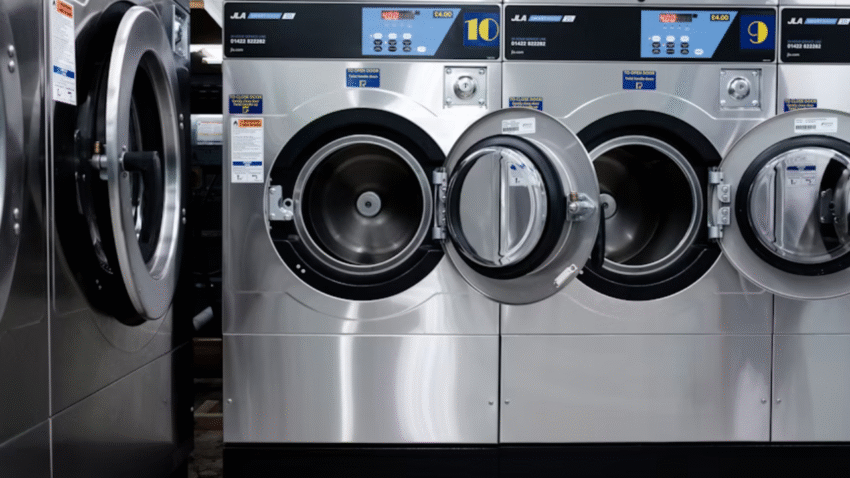Introduction
Smart home technology isn’t just for lights and voice assistants — it can make your laundry room more efficient, too. By adding a smart plug to your washer and dryer, you can monitor energy use, get alerts when cycles finish, and even schedule loads for off-peak electricity times. This guide will show you step-by-step how to add a smart plug to a washer and dryer, so you can enjoy a more connected, convenient laundry routine.
Why Adding a Smart Plug Matters for Your Laundry Room
Smart plugs can transform your laundry routine by offering:
- Energy monitoring to help reduce electricity costs.
- Remote control to turn appliances on or off from your phone.
- Cycle completion alerts so you never forget wet clothes in the washer.
- Scheduling features to run laundry during cheaper, off-peak hours.
- Increased safety by cutting power remotely in case of an issue.
With the right setup, you can make laundry more efficient and even extend the lifespan of your appliances through smarter use.
Step-by-Step Guide to Adding a Smart Plug to a Washer and Dryer
Step 1: Choose the Right Smart Plug
Not all smart plugs are built for heavy-duty appliances. Look for:
- High power capacity (at least 15 amps for most washers and dryers).
- Wi-Fi compatibility with your preferred smart home ecosystem (Alexa, Google Home, Apple HomeKit, etc.).
- Energy monitoring features if you want to track electricity use.
- Safety certifications such as UL or ETL listings.
Note: Most electric dryers require a 240-volt outlet, which standard smart plugs do not support. For dryers, you may need a specialized 240V smart plug or smart energy monitor instead. Gas dryers, which plug into standard 120V outlets, can typically use regular smart plugs.
Step 2: Check Compatibility with Your Appliances
Before buying, check your washer and dryer manuals to ensure adding a smart plug won’t void the warranty. Also, make sure your machines do not require constant manual restarts after a power cut — otherwise, remote control functions may be limited.
Step 3: Prepare the Laundry Area
- Turn off your washer and dryer.
- Unplug them from the wall outlet.
- Move them slightly if needed to access the outlet safely.
Step 4: Install the Smart Plug
- Plug the smart plug into your wall outlet.
- If it has a reset button, press it to prepare for setup.
- Plug your washer or dryer into the smart plug.
For dryers requiring 240V power, install the specialized 240V smart plug according to the manufacturer’s instructions or hire a licensed electrician.
Step 5: Connect to Wi-Fi and App
- Download the manufacturer’s app for your smart plug.
- Follow in-app instructions to connect the plug to your home’s Wi-Fi network.
- Name the plug something clear like “Washer” or “Dryer” so you can control it easily with voice commands or schedules.
Step 6: Test the Setup
- Use the app to turn the appliance on and off.
- Run a short cycle to see if the smart plug detects power usage.
- If using energy monitoring, check the live readings during the cycle.
Step 7: Set Schedules and Alerts
- Program the plug to turn on during off-peak energy hours.
- Enable push notifications to alert you when the washer or dryer cycle finishes (based on power draw changes).
- If compatible, link the plug to your voice assistant for hands-free control.
Common Mistakes to Avoid
- Using the Wrong Type of Smart Plug
- Mistake: Installing a standard 120V smart plug on a 240V dryer outlet.
- Solution: Always match the plug type to your appliance’s voltage.
- Ignoring Power Ratings
- Mistake: Choosing a plug that can’t handle your washer’s or dryer’s amperage.
- Solution: Check your appliance’s wattage and amperage before buying.
- Forgetting Wi-Fi Strength
- Mistake: Weak Wi-Fi in the laundry room leads to disconnections.
- Solution: Use a Wi-Fi extender if needed.
- Skipping Safety Certifications
- Mistake: Buying a cheap, uncertified plug that may pose a fire risk.
- Solution: Choose UL- or ETL-listed products.
- Expecting Full Remote Start
- Mistake: Thinking you can start a wash cycle entirely from your phone.
- Solution: Most washers require manual load setup; the plug can only control power.
Extra Laundry Tips & Hacks with Smart Plugs
- Pair with a Water Leak Sensor: Get instant alerts if your washer leaks.
- Track Energy Usage: Identify which laundry cycles use the most power to save money.
- Create Automation Routines: For example, have the washer power off automatically after completing a cycle.
For more ways to modernize your laundry space, check out our guide on How to Add Soundproofing to a Noisy Laundry Room to make the experience quieter as well as smarter.
Conclusion
Adding a smart plug to your washer and dryer is a quick and affordable way to make laundry more efficient, track energy use, and gain remote control over your appliances. By choosing the right plug, installing it correctly, and taking advantage of app-based features, you can bring your laundry room into the smart home era without complicated wiring or expensive upgrades.
Bookmark this guide so you can follow these steps the next time you want to upgrade your laundry setup with smart technology.
